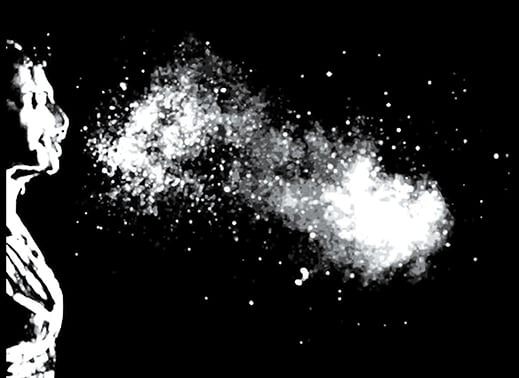The next time you feel a sneeze coming on, raise your elbow to cover up that multiphase turbulent buoyant cloud you’re about to expel.

That’s right: a study by MIT researchers shows that coughs and sneezes form gas clouds that keep their potentially infectious droplets aloft over much greater distances than anyone previously realized.
“When you cough or sneeze, you see the droplets, or feel them if someone sneezes on you,” says John Bush, a professor of applied mathematics and coauthor of a new paper on the subject. “But you don’t see the cloud, the invisible gas phase. The influence of this gas cloud is to extend the range of the individual droplets, particularly the small ones.”
The study finds that droplets 100 micrometers—or millionths of a meter—in diameter travel five times farther than previously estimated, while droplets 10 micrometers in diameter travel 200 times farther. Droplets less than 50 micrometers can frequently remain airborne long enough to reach ceiling ventilation units.
With this in mind, architects and engineers may want to reëxamine the design of workplaces and hospitals, or air circulation on airplanes, to reduce the chances that airborne pathogens will be transmitted.
“You can have ventilation contamination in a much more direct way than we would have expected originally,” says Lydia Bourouiba, an assistant professor in the Department of Civil and Environmental Engineering and another coauthor of the study, published in the Journal of Fluid Mechanics.
The researchers used high-speed imaging of coughs and sneezes, as well as laboratory simulations and mathematical modeling, to determine how the droplets behave. Others had previously assumed that larger mucus droplets fly farther than smaller ones, because they have more momentum. It turns out to be more complicated, however, because of the way a cough or sneeze forms what they term a “multiphase turbulent buoyant cloud,” mixing with surrounding air before its payload of liquid droplets falls out, evaporates into solid residues, or both.
“If you ignored the presence of the gas cloud, your first guess would be that larger drops go farther than the smaller ones and travel at most a couple of meters,” Bush says. “But by elucidating the dynamics of the gas cloud, we have shown that there’s a circulation within the cloud—the smaller drops can be swept around and resuspended by the eddies within a cloud, and so settle more slowly.”
Given local air conditions, researchers can now better estimate the reach of a given expelled pathogen. “Where does the pathogen actually go?” Bush says. “The answer has changed dramatically as a result of our revised physical picture.”
Keep Reading
Most Popular
Large language models can do jaw-dropping things. But nobody knows exactly why.
And that's a problem. Figuring it out is one of the biggest scientific puzzles of our time and a crucial step towards controlling more powerful future models.
How scientists traced a mysterious covid case back to six toilets
When wastewater surveillance turns into a hunt for a single infected individual, the ethics get tricky.
The problem with plug-in hybrids? Their drivers.
Plug-in hybrids are often sold as a transition to EVs, but new data from Europe shows we’re still underestimating the emissions they produce.
Stay connected
Get the latest updates from
MIT Technology Review
Discover special offers, top stories, upcoming events, and more.